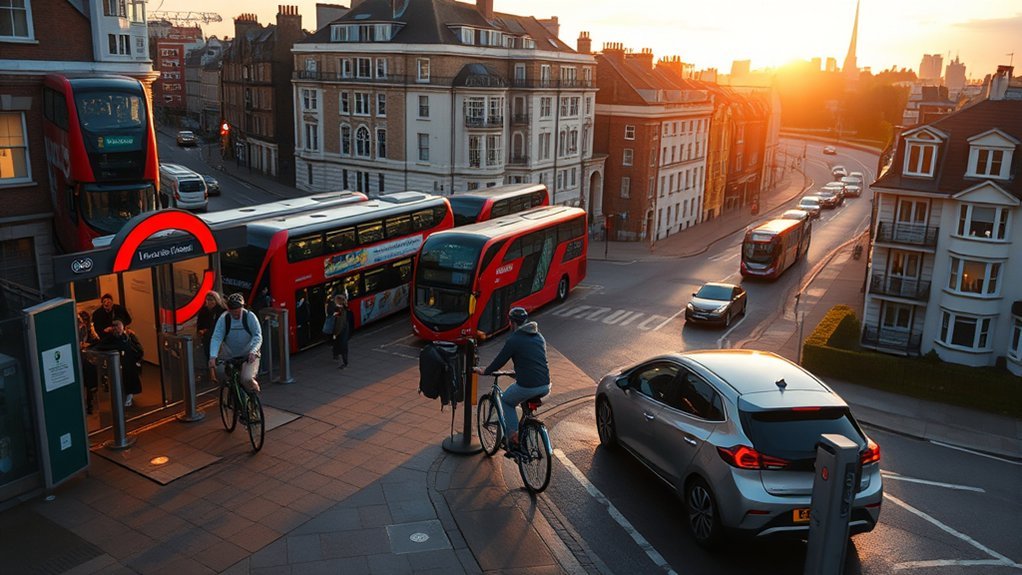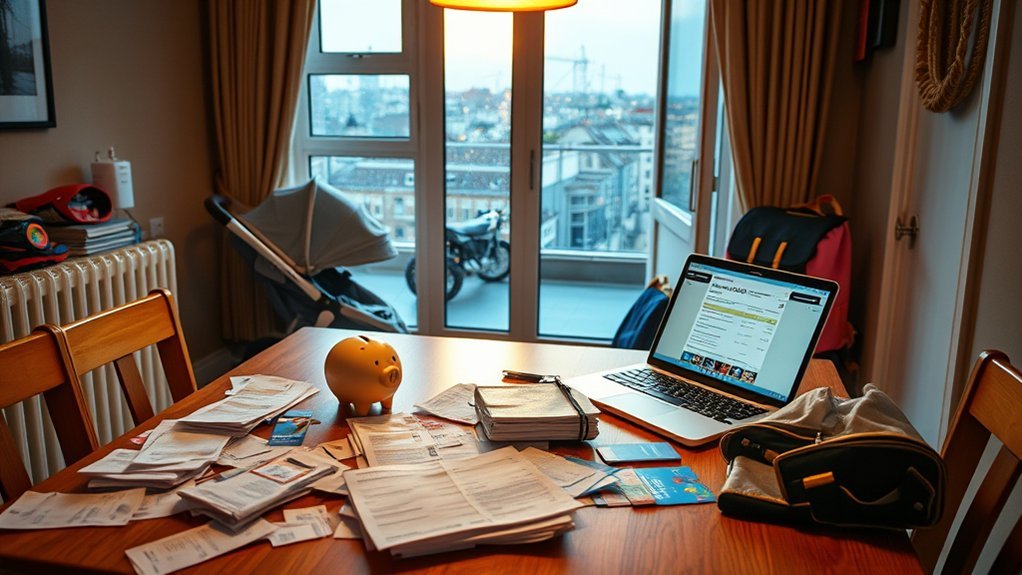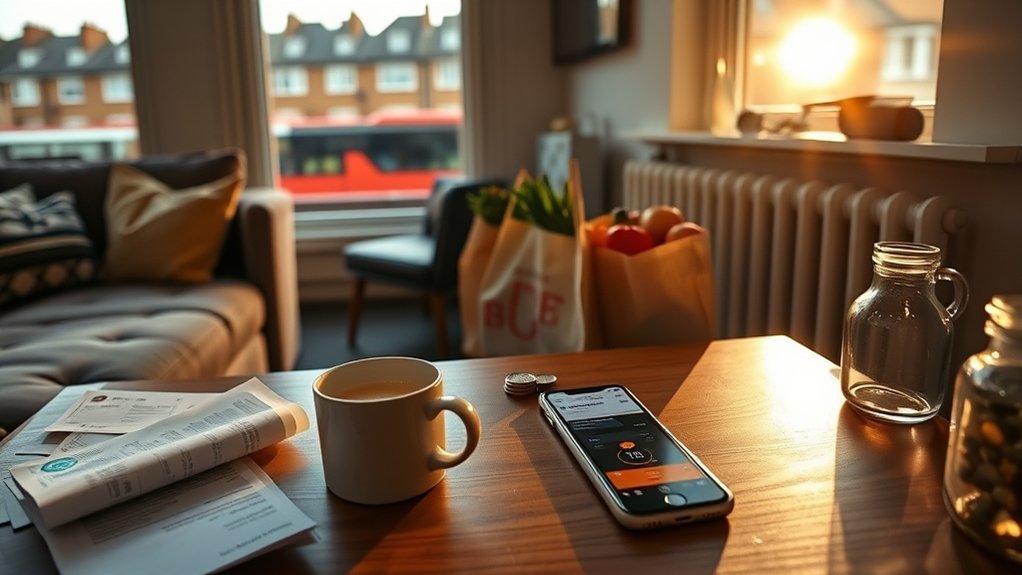You’ll typically need around £3,200 net per month to cover modest living in London. Central one‑bed rents average about £2,280/month, outer zones drop to ~£1,700 but add commuting costs. Expect utilities, council tax and bills of £250–£450/month, groceries £200–£300, and transport £150–£270 if commuting. Flat‑shares and Zones 3–6 cut costs most. Keep rent under 30–40% of take‑home pay and continue for practical tips and numbers.
Rent Prices Across London Zones

Although central London commands the highest rents, you can cut housing costs substantially by moving to outer zones. When you compare rent prices in London, Zones 1–2 show a typical 1-bedroom rent around £2,280 (range £1,800–£3,000), reflecting steep central London rent pressure.
In Zones 3–6 the 1-bedroom rent falls to roughly £1,709/month (range £1,400–£2,000), so shifting a couple of zones lowers your baseline by several hundred pounds.
If you need larger space, a 2-bedroom in central areas commonly starts near £2,500 and a 3-bedroom averages about £3,818/month (range £3,000–£6,000), reinforcing cost benefits of outer boroughs rent.
Flatshare room prices are the most effective saving: typical room-in-flatshare rates range £600–£1,200, with an average around £1,000 in 2023. For the lowest 1-bedroom ask in outer districts, consider the Bexley average near £1,124 as a clear benchmark. Additionally, understanding building costs can help in financial planning for housing decisions.
Utilities, Council Tax and Monthly Bills

Expect basic utilities for an 85 m² flat to average about £242/month (typical range £159–£442), with one-bedroom flats commonly quoted £150–£250 and higher costs in cold months. Council tax depends on borough and band—Band D is roughly £1,700–£1,966/year (about £142–£164/month) but can be higher locally. Adding broadband (£25–£35), mobile (~£20) and a TV licence (~£13.25/month) means total household bills commonly land in the £250–£450/month range, rising if you work from home or face energy-price spikes. Regular maintenance tips for your home can help manage these costs effectively.
Typical Monthly Utilities
When you budget for living in London, plan on monthly recurring bills of roughly £250–£400 for a typical household: basic utilities (gas, electricity, water) average about £242/month for an 85 m² flat (typical range £159–£442), one‑bed flats commonly see £150–£250 with higher costs if you work from home, council tax adds around £150+ per month (Band D ≈ £1,700–£1,966/year) with possible single‑occupant or student discounts, broadband runs about £25–£38/month, and a TV licence costs £159/year (≈£13.25/month) if you watch live TV or BBC iPlayer.
Expect gas and electricity to drive most utility bills; monitor usage, compare suppliers, and cap costs where possible to keep average bills manageable.
Council Tax Breakdown
If you’re budgeting for monthly living costs in London, council tax is a predictable line item: a Band D property typically costs about £1,700–£1,966 a year (roughly £142–£164/month), though the exact amount depends on borough and property band. You’ll want to factor borough variation and council tax bands into your plan: higher council tax rates in some boroughs push monthly council tax up, lower bands reduce it. Many single occupants get a 25% single-person discount, cutting a Band D bill by about £35–£41/month. Check your tenancy—landlords sometimes include water or utilities. Other monthly bills (broadband, mobile, TV licence) add extra predictable costs you should add to your cashflow.
| Item | Typical monthly |
|---|---|
| Band D council tax | £142–£164 |
| Single‑person discount saving | £35–£41 |
Transport Costs and Commuting Trade‑offs

You’ll want to weigh shorter commutes against higher rent by comparing clear numbers: central one‑bed averages ~£2,281 vs ~£1,709 outside the centre, but travel from outer zones typically adds £150–£270/month and longer journey times.
A Zones 1–3 monthly pass is about £171–£180, while pay‑as‑you‑go trips average ~£3 each, so daily commuters usually save with a pass.
Also consider cheaper options like Santander Cycles or e‑bike subscriptions (£36–£40/month) if they cut journey time without the higher rent. Regular inspections can help identify issues early that may affect the efficiency of your transport choices.
Commuting Time Vs Rent
Although moving to outer zones can cut your one‑bed rent from roughly £2,280 to about £1,709 (or even around £1,124 in places like Bexley), you’ll usually trade lower rent for higher monthly travel costs and longer commute times—expect Zone 1–3 monthly passes near £156–£180 and Zone 1–6 around £270, with daily Tube caps (~£8.90) and weekly spends (~£44.70) adding up quickly; factor in that many renters offset central rents by flat‑sharing (£600–£1,200 for a room) plus a travelcard, and that driving brings extra petrol (~£1.41/L), congestion/ULEZ and parking charges, so rent reductions often shrink once transport and time costs are included.
- Compare rent prices for Zone 1–2 vs Zone 3–6.
- Add monthly travelcard or weekly fares to your budget.
- Weigh flat‑sharing savings against commuting time.
- Consider driving costs versus public transport when calculating cost to live.
Public Transport Costs
Weigh up the trade‑offs: while moving farther out can cut your rent, your weekly or monthly travel bill usually rises enough to erase much of that saving.
If you use public transport regularly, a one‑way fare averages ~£3 (£2–£5), with Tube fares and pay as you go daily caps near £8.90 for Zones 1–2 and weekly cap around £44.70. A monthly travelcard typically sits near £180 (range £107–£228); a Zone 1–3 example is ~£171.70, while Zone 1–2 monthly caps are lower.
Many commuters find Zones 3–6 rent savings offset by higher transport costs and longer commutes.
For short hops, Santander Cycles or e‑bikes (unlock ~£1, £0.27/min) reduce total transport costs versus owning a car.
Grocery and Food Expenses

Getting your weekly groceries in London will eat up a noticeable chunk of your budget, but how much depends on where you shop and whether you cook at home. If you cook regularly, expect to spend about £200–£300 monthly on groceries; shopping at budget supermarkets like Lidl or Aldi can keep it under £200. Typical prices: milk £1.30/l, bread £1.57 (500g), eggs £3.69 (12), apples £2.55/kg, chicken fillets £6.52/kg.
- Plan meals: buying staples in bulk lowers your monthly grocery budget and avoids impulse buys.
- Use markets and discounters: you can reduce food expenses noticeably compared with big chains.
- Compare unit prices: per-kilo and per-litre comparisons reveal real savings on protein and produce.
- Mix home cooking with occasional street food: street food meals (£5–£15) give variety without the high cost of sit-down restaurants.
Additionally, regular maintenance of kitchen appliances can help prevent unexpected costs that may impact your overall budget. Household budgets including baby items, snacks, and alcohol often hit ~£1,000; tailor your approach to your needs.
Eating Out, Entertainment and Leisure

After you’ve sorted grocery routines and learned where to save, you’ll find eating out and leisure costs follow a different pattern and can quickly change your monthly spending.
Once groceries are tamed, eating out and leisure habits can swiftly reshape your monthly budget.
When eating out in London, a Mid-range Restaurant three-course meal for two averages £20 (range £13–£30), while a McMeal is about £8 (£6–£12). Coffee runs add up: a cappuccino averages £3.90 (£2.75–£5.00). Pubs and casual nights cost more than you expect; a domestic draught beer (0.5L) is roughly £6.50 (£4.50–£7.50).
For entertainment, budget cinema tickets for international releases at around £15 (£10–£19), and West End theatre matinees or discounted seats generally start from £35.
Monthly discretionary spending for takeout and casual dining typically sits at £100–£150, but nightlife and fine dining push this higher. Additionally, consider the importance of financial planning to effectively manage your overall budget and spending habits.
If you use paid facilities, a monthly fitness club membership averages £47.09 (£30–£80). Complement paid options with free museum entries to moderate leisure costs.
Salaries, Take‑Home Pay and What Counts as “Good” Pay

Because rent eats a big slice of your budget, what counts as “good” pay in London depends heavily on where you live and whether you share, with a recommended net monthly income of about £3,200 to cover average rent, bills and basic living costs without heavy trimming.
The average net monthly income is ~£3,151, but median and many earners sit in the low £2,000s; about half earn under £2,300. A £60,000 gross salary leaves roughly £3,654 take-home pay after income tax and National Insurance — useful as a benchmark.
- Rent pressure: a central 1-bed flat can be ~£2,280/month, outside centre ~£1,709 — rent often exceeds half of many net salaries.
- Take‑home pay: compare gross salary to net monthly income after income tax to assess affordability.
- What’s “good”: ≥£3,200 net/month (or £40k–£60k+ gross) lets you live without constant trimming.
- If you earn <£30k, expect flatshares or outer zones to manage London’s cost of living.
Additionally, it’s crucial to consider long-term financial implications when evaluating your budget for rent and living expenses in the city.
Childcare, Education and Family Costs

Though the numbers vary, childcare and schooling are often the single biggest drains on a London family budget: full‑day private nurseries average about £1,920/month (commonly £1,250–£2,400), international primary schools run around £20,758/year (typical £15k–£30k), and even private day schools can cost from a few thousand to over £20k annually.
You’ll find private nursery fees eat into monthly cashflow quickly, and international school fees or expensive day schools can rival mortgage or rent.
State schools are free for resident children aged 5–18, but you’ll still budget for uniforms, meals, trips and extracurriculars.
Schemes like 30‑hours free childcare, tax‑free childcare and employer childcare benefits can reduce net childcare costs, though eligibility and coverage vary.
Because childcare costs plus higher London rent frequently consume much of household income, family living expenses can leave little room for savings — many households on combined nets around £4,500/month report tight finances despite both partners working. Additionally, government grants may be available to assist families with childcare costs, helping to alleviate some financial pressure.
Budgeting Strategies and Money‑Saving Tips

If you want to keep living in London without constantly worrying about money, start by aligning your net income and major bills: aim for at least £3,200/month if you’re renting solo or reduce pressure by flat‑sharing (shared rooms £600–£1,200/month) and keeping rent to roughly 30–40% of take‑home pay by choosing Zones 3–6 where a 1‑bed can be ~£1,709/month instead of central rates near £2,281. Use this baseline to set a realistic budget and monitor cash flow monthly. Prioritise rent, utilities and transport, then flex on discretionary spending. Shop Lidl/Aldi and markets to cut food to £200–£300/month; limit takeout. Grab monthly travelcards or use PAYG caps; cycle when practical. Review subscriptions and switch utility providers annually. If you’re flat‑sharing, split bills and track contributions transparently to avoid disputes. Regular inspections can catch hose issues early, which is similar to budgeting for unexpected expenses.
- Calculate required net monthly income and cap rent at 30–40%.
- Choose Zones 3–6 to lower rent and commute costs.
- Use Lidl/Aldi, meal‑plan, minimise takeout.
- Buy travelcards, share utilities, cancel unused subs.
Frequently Asked Questions
How Much Does It Cost to Live in London per Month With Rent?
You’ll pay roughly £1,800–£3,800+ monthly with rent; add transport costs, utility bills, food shopping, groceries delivery, phone plans, local taxes, health insurance and an entertainment budget to reach about £2,800–£5,500 total.
Can I Live off $1000 a Month in London?
No — you can’t safely live on $1,000/month in London. Using shared housing, cheap eats, commute savings, part time jobs, seasonal work, student discounts, budgeting apps and free entertainment helps, but the gap remains large.
Can You Live in London With 3,000 Pounds a Month?
Yes — you can, but you’ll need careful budgeting: cost breakdown (rent, utility bills, groceries budgeting), neighborhood selection and commute impact affect costs, limit social life and entertainment choices, and plan for unexpected expenses to stay afloat.
Is $1500 a Month Enough to Live in London?
Short answer: no — think of it as squeezing a balloon. You could manage with shared housing, part time work, strict budgeting apps, low food costs, a transport pass, careful neighborhood choice, accounting visa expenses and tiny entertainment budget.
Conclusion
Think of London as a layered map: zone rent is the base, bills and council tax are the streets, groceries and transport the daily steps. You’ll balance childcare, leisure and take‑home pay like a compass—small savings tilt your route. Use data to set clear monthly caps, track spending, and prioritise zones or services that give most value. With practical budgeting and informed trade‑offs, you’ll turn London’s complexity into a navigable, reliable plan.


